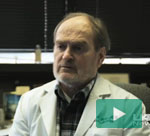New Insights Into a Devastating Disease
By Laura Freeman
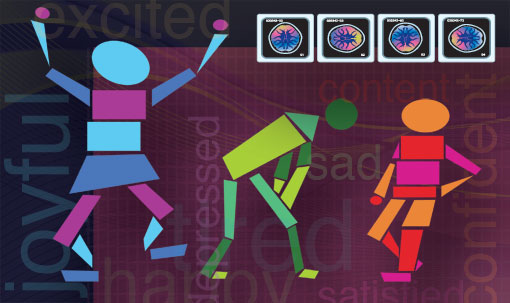
You can’t see the wind, but you can see the destruction a windstorm leaves behind. That is a perfect picture of autism. The developmental disorder doesn’t readily show up on X rays or in lab tests. Doctors and other diagnosticians, such as psychologists, have to rely on observed delays and differences in socialization, communication, and behavior—making their diagnosis by observing the effects of the disease rather than the disease itself.
These difficulties place the burden on parents to report symptoms to professionals such as physicians, teachers, or other clinical specialists and on those professionals to act on these warning signs. The sense of urgency has become even greater in recent years; studies have shown that early diagnosis and treatment is crucial to a person’s success in coping with the disorder over a lifetime.
UAB researchers and clinicians are responding by focusing their efforts on new methods to track, diagnose, and treat autism as early in life as possible. They are contributing fresh insights into some of the disease’s most slippery problems.
Question: How many children are affected by autism?
If you plot the incidence of autism in the United States on a graph, the past 20 years look like the face of a cliff. In 1990, when the definition of autism was limited to those with the most profound symptoms, the condition was thought to affect one person in 2,000. But those numbers changed dramatically when experts decided to group autism and less severe conditions such as Asperger’s syndrome into a unit known as the autism spectrum disorders (ASDs).
 |
At UAB’s new Medical Autism Clinic, children can be evaluated by specialists in one location, expediting care for the range of health problems that accompany autism spectrum disorders. |
But semantics alone can’t explain the continuing increase in diagnoses. In a study of eight-year-olds conducted by the Centers for Disease Control and Prevention (CDC) in partnership with UAB and 10 other research sites in the United States, the incidence of ASDs rose from 1 in 150 in 2004 to 1 in 110 in 2006.
“In addition to the broader definition, the increase may be coming, at least in part, from the growing awareness of the condition in the community,” says Beverly Mulvihill, Ph.D., an associate professor in the UAB Department of Health Care Organization and Policy specializing in maternal and child health and co-investigator on the CDC study. “Parents, doctors, teachers, and other professionals are recognizing the symptoms and referring children for screening.”
The study wasn’t able to determine whether the actual risk of developing an ASD is rising, or reasons for such an increase. But it did uncover one statistic that might provide important clues. “We found that boys are 4.5 times more likely than girls to have an ASD,” says Mulvihill. “Science still has a way to go in determining the exact causes of these disorders, but one theory is that there is a genetic link, possibly with an environmental trigger. Families with one child with an ASD seem to be more likely to have another child who will develop the problem. We are also looking at the data to see if we can identify links to vulnerabilities such as low birth weight and other factors.”
What is clear is that autism cuts across socioeconomic and geographic boundaries, says Mulvihill. “The prevalence we found in the United States is consistent with reports from Europe and other parts of the world.”
Working with UAB co-investigator Martha Wingate, Dr.P.H., assistant professor in the Department of Health Care Organization and Policy, Mulvihill gathered data on the incidence of ASDs among eight-year-olds in Alabama’s 32 northern counties. The Alabama Autism Surveillance Project, located within the health-care organization and policy department, is a member of the national Autism and Developmental Disabilities Monitoring (ADDM) network.
|
Autism in the Classroom 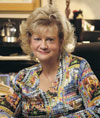
UAB associate professor Karen Bowen Dahle, Ed.D., helps train regular and special education teachers how to recognize children with autism spectrum disorders and how to help them learn. Read more |
“At first glance, Alabama’s 1 in 165 incidence rate appears better than the national average,” Mulvihill says. “However, some states with a higher incidence have access to school records. When the 2010 data are analyzed and we have access to school records for the first time, we expect the prevalence in Alabama to be consistent with that in other states.”
The primary goal of the current study was to “get a clearer picture of how many people have ASDs so we can plan for future needs for health, social, and educational services,” Mulvihill says. Alabama families dealing with autism have the support of strong advocacy efforts through the Alabama Autism Task Force, the Interagency Autism Coordinating Council, and the Autism Society of Alabama, she notes.
“While medical researchers work on understanding ASDs and identifying new avenues of treatment, having adequate resources in place for early diagnosis and early intervention is one of the most important things we can do to help patients and their families,” Mulvihill says.
Question: How does autism affect the brain?
If researchers could get a clearer picture of how autism works, they could potentially reveal new clues to the causes of the disorder and new ways to prevent and treat it.
To bring that picture into focus, Rajesh Kana, Ph.D., director of UAB’s Autism Brain Imaging Research Laboratory in the Department of Psychology, is using functional magnetic resonance imaging (fMRI) to pinpoint the differences between autistic and non-autistic brains.
“The fMRI allows us to see changes in the blood flow in the brain as people perform different tasks,” says Kana. “When we compare the areas of the brain that are active in people with ASDs to other people performing the same tasks, we are seeing significant differences.”
In a recent study in Kana’s lab, teens with high-functioning autism or Asperger’s syndrome—one of the milder ASDs—were shown cartoon vignettes. After they studied the action in each frame, participants were asked to choose the most logical next image.
“On a vignette showing a wine glass falling, the ASD subjects did relatively well choosing the next frame—one that showed a broken glass,” Kana says. “However, on vignettes showing social interaction, they didn’t do as well. For example, one scene showed a man watching a street musician. He takes out a coin from his wallet. What is he going to do? Give the coin to the musician or feed a parking meter? Many people with autism had difficulty in choosing the correct answer.” (See the illustration below.)
When participants with ASDs looked at images of social interaction, there was comparatively lower blood flow to areas of the brain associated with understanding and interpreting the motives and intentions of others. “The body language, facial expression, tone of voice, and verbal cues that most of us use to put social interactions into context don’t seem to be processed and integrated the same way in the brains of people with autism,” says Kana. “That could be a big part of why people with an ASD have more difficulty with social situations and communication.”
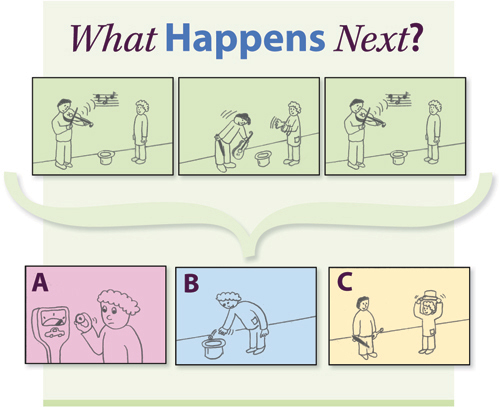 |
When UAB researcher Rajesh Kana showed this illustration to study participants with autism, they had difficulty choosing the bottom picture that best finished the story. |
Another study from Kana’s lab examined how subjects access and process information from different areas of their brains to allow them to understand multiple meanings of words and utterances, Kana says. “For example, when hearing a pun like ‘I was fired from the orange juice factory because I couldn’t concentrate,’ our control subjects recognized the humor immediately. But our ASD subjects didn’t get it.”
But why is information that is so readily available to others not accessible to people with ASDs? Does the information not reach those areas of the brain? Are those areas not working as well? Or could it be a failure in coordinating information to draw conclusions?
Although initial findings suggest a failure in cross talk among brain regions in people with ASDs, it is also possible that the wires connecting these regions (known as axonal fibers, or “white matter”) are not in the best shape, Kana says. “The white matter fibers, which are laid out in several different directions in the brain, may provide the medium for cross talk between brain areas,” he explains. “If there is a problem in the organization or in the quality of these fibers, that may affect the communication between brain areas, which may be the case in autism. This is like a football team where the players have no coordination among themselves and end up functioning poorly.”
In one recent study, Kana’s team examined water diffusion in the brain (an index of white-matter integrity) using a new technique called diffusion tensor imaging (DTI). “White-matter integrity was significantly lower in subjects with ASD in a few areas,” Kana says. “Interestingly, one of these areas was the posterior part of the temporal lobe”—a region that is actively involved in social thinking.
Kana is now planning new studies to delve further into these trouble spots and integrate the findings from DTI and fMRI in order to derive a comprehensive picture of brain organization and functioning in people with autism. He also teaches an undergraduate course that provides a comprehensive overview of ASDs from clinical, research, education, and parents’ perspectives.
Question: When should autism treatment begin?
We aren’t born with the ability to button a button or tie a shoe, but as our brains develop and we practice these essential life skills, neural pathways develop and solidify, and eventually we can do them almost automatically. This development isn’t linear, however; there are seasons in a child’s life when the brain is developing rapidly, and everything from language to walking becomes easier to learn. If children miss those golden windows of opportunity, it becomes very difficult for them to catch up.
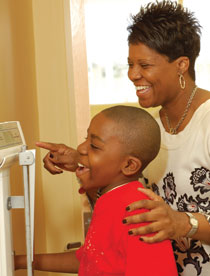 |
When her son was diagnosed with an autism spectrum disorder while she was in medical school, LaTamia White-Green made the disease her specialty. She is now director of the UAB Civitan-Sparks Autism Clinics. |
“Many children with autism spectrum disorders lose precious years of foundation-building to delays in diagnosis,” says LaTamia White-Green, M.D., medical director of UAB Civitan-Sparks Clinics. “Some families sense that something is wrong, but they don’t have the financial resources to seek an evaluation. Others tell us they’ve been on a waiting list a year or more, or end up waiting for one consultation, then another and another, trying to get an answer to what is going on and get help.”
White-Green chose autism as her specialty when her son was diagnosed with pervasive developmental disorder, not otherwise specified (known as PDD NOS), a mild form of autism, while she was in medical school. “Having experience as a parent of a child with an ASD helps me think as both a parent and a clinician,” she says. “When I give parents my advice, I can tell them it’s what I would do myself.”
“The Civitan-Sparks Clinics have an autism diagnostic clinic for preschoolers and another for school-age children that gather an interdisciplinary team in one place for a comprehensive evaluation,” says White-Green. “Our psychologists, speech-language pathologists, occupational therapists, and others work together to confirm or rule out the diagnosis and assess the severity of symptoms.”
The clinics also offer therapy services to address specific issues. “We have a social skills class that will start in the late fall or early winter to address poor socialization skills, and my autism psychopharmacology clinic provides medication management for aggressive and impulsive behaviors,” says White-Green.
“Since children with autism often have difficulty communicating well enough to have their basic needs met, you can imagine the frustration,” she adds. “It’s like being in a country where you don’t speak the language or understand the customs. Talking louder doesn’t help—that can lead to aggression or withdrawal and trigger other problems. But if we can improve communication and defuse aggression, life is better for the whole family.”
Because a range of other health problems often accompany ASDs, UAB has opened a new Medical Autism Clinic, which brings together a number of specialists in one location to assess a child’s overall health and help parents get their children appropriate medical care in a timely manner.
“Autism can be complicated—several co-morbidities can be associated, from motor problems to fine motor difficulties to seizure disorders,” says clinic director Myriam Peralta-Carcelen, M.D. “A hearing test is one of the first things we do, since communication is such an important issue. There may be sleep disorders related to behavior or physical problems such as apnea. Some children are hypersensitive to noise, taste, or touch, and others may be less sensitive and less able to feel pain.”
Gastrointestinal and nutritional problems are also common, Peralta-Carcelen continues. “Children may be picky eaters and restrict their diet because of how they perceive tastes and textures. In those cases, our nutritionists and feeding specialists can help them find other foods to meet their nutritional needs.”
Problems such as fragile X syndrome and other genetic deletions can also be a possibility, and genetic screening is available for both patients and their families. After evaluating a child’s overall health, the team works together to develop a care plan to see that all medical issues are addressed. “For example, if there are motor problems, we put them in touch with physical therapy,” says Peralta-Carcelen. “We usually do at least one follow-up and call to see how the care plan is working.”
To schedule an appointment at the Medical Autism Clinic, call (205) 939-5275. To schedule an appointment at the Civitan-Sparks Autism Clinics, call (205) 934-5471.
More Information
Read more about the Medical Autism Clinic in this article from the UAB Reporter.
